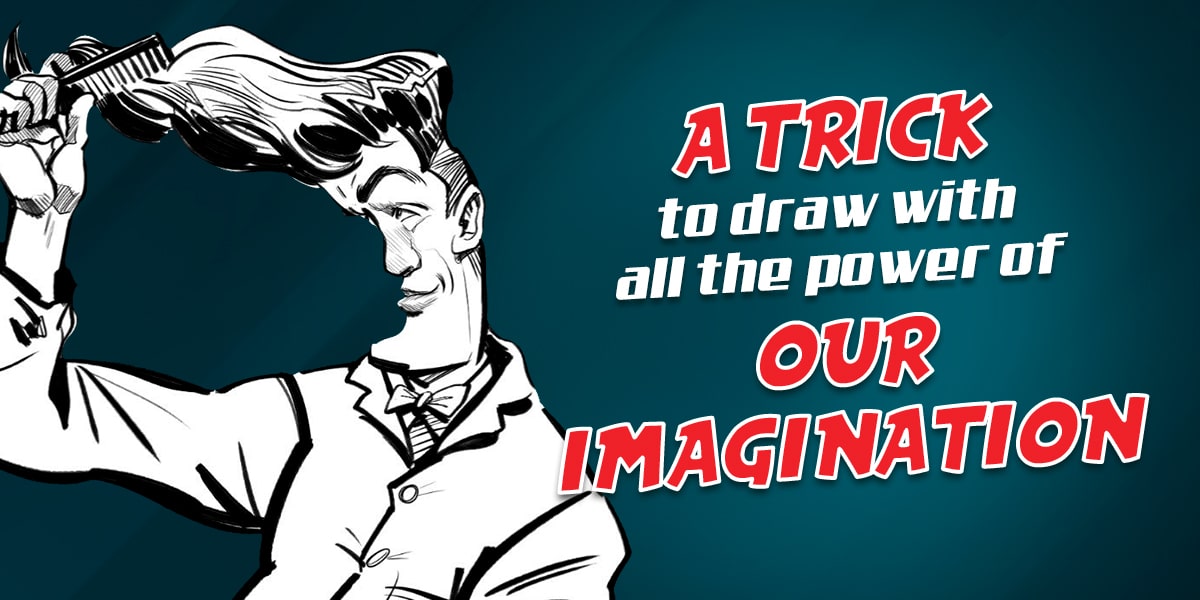A trick to draw with the full power of our imagination
Have you ever looked at a cloud and seen a dragon? Or found a face in the bark of a tree? You’re not alone. This phenomenon, known as pareidolia, is a gateway to a world of unlimited creativity for artists and illustrators. In this article, we’ll explore how to harness this fascinating trick of the mind to enhance our imagination and create unique and surprising works of art.
The hidden power of pareidolia in art
Pareidolia is more than just a curiosity; it’s a powerful tool that artists have used for centuries to stimulate their creativity. This phenomenon allows us to see familiar patterns in random objects, transforming the mundane into the extraordinary. For illustrators and visual artists, mastering this skill can open up a world of creative possibilities.
Imagine being able to create fascinating characters from the shape of a rock, or design a futuristic spaceship inspired by the silhouette of an insect. Want to take your imagination to the next level? Discover how here. Pareidolia allows us to see beyond the obvious and find inspiration in the most unexpected places.
Nature as an inexhaustible source of inspiration

Clouds are an ever-changing canvas, offering ephemeral shapes that challenge our imagination. Is that a submarine sailing through the sky? Or perhaps a whale swimming among air currents? This game of identifying shapes in clouds is not just a childhood pastime; it’s a creativity exercise that can fuel your art.
Next time you find yourself under a cloudy sky, take a moment to observe. Carry a sketchbook with you and capture those fleeting shapes. You could be drawing the next iconic character for your story or the landscape of a fantastic world you haven’t created yet.

Nature is an artist in its own right, sculpting intriguing shapes in rocks and landscapes. This image shows a rock that seems to have been carved with the profile of a human face. Such natural formations have inspired legends and myths throughout history, and can be the starting point for your own visual narratives.
Click here to explore techniques that will help you capture the essence of these inspiring landscapes. Learn to transform these visions of nature into art that tells stories and evokes emotions.

In the Andes mountain range, a rock formation known as “Los Penitentes” owes its name to its resemblance to a procession of monks. This is a perfect example of how pareidolia can influence even the culture and nomenclature of places. As an artist, you can leverage these associations to create works that deeply connect with human history and psychology.

This drawing clearly illustrates how the human mind interprets natural shapes, transforming simple rocks into meaningful figures. As an artist, your challenge is to capture that essence and take it further, creating worlds and characters that resonate with the viewer’s imagination.
Redefining objects: An exercise in unlimited creativity
One of the most powerful exercises to stimulate creativity is the redefinition of objects. This process involves taking an everyday object and transforming it into something completely new and different, maintaining its basic shape but altering its function and context.

Lyonel Feininger, a master of fantastic comics, shows us how a simple bathtub can become a surreal vessel. This type of transformation is not only fun, but it also challenges our perception of everyday objects and invites us to see the world differently.

Doug Chiang, renowned for his work on Star Wars, takes redefinition to another level by transforming animal features into an imposing spaceship. This approach not only creates unique designs but also infuses a sense of familiarity into the unknown, making even the most alien creations have a touch of recognizability.
Ready to create your own futuristic designs? Discover tools and techniques here. Learn to combine disparate elements to create innovative visual concepts that capture the imagination.
Masters of redefinition in art


Carlos Nine, a prolific Argentine artist, elevated redefinition to an art form in itself. In these images, we see how everyday objects are transformed into a surreal city. What at first glance appears to be a strange metropolis is actually composed of common household items, ingeniously arranged to create an urban illusion.
This approach not only challenges our perception but also invites us to reconsider the objects around us. As an artist, you can apply this principle to create fantastic scenarios from the mundane, transforming the familiar into something extraordinary and captivating.
Arcimboldo: The Renaissance precursor of redefinition


Giuseppe Arcimboldo, a 16th-century Italian painter, was a pioneer in the art of redefinition. His famous portraits, composed of fruits, vegetables, and other objects, are a testament to the power of imagination and artistic skill to transform the ordinary into the extraordinary.
In these images, we see how Arcimboldo used vegetables and kitchen utensils to create a surprising portrait. The fascinating thing is that, when inverting the image, we find an apparently common still life. This visual play not only demonstrates the artist’s technical skill but also invites us to question our perception of reality.
Enter here to perfect the art of creative composition. Learn to combine disparate elements to create works that challenge perception and stimulate the viewer’s imagination.
Practical exercises to awaken your creativity
Exercise 1: Transforming everyday objects
This exercise will help you see beyond the original function of an object and discover its hidden creative potential. Follow these steps:
- Select an industrially produced object of medium complexity. Avoid objects that are too simple like a glass or too complex like an elaborate machine. A bazaar item, a construction tool, or a musical instrument can be excellent choices.
- Make several studies of the object from different angles. Carefully observe its shapes and structures.
- As you draw, let your mind wander. What other shapes or creatures do the contours and details of the object suggest to you?
- Use a colored marker to redraw over your sketches, transforming the object into something completely new. Don’t be afraid to modify, add, or remove elements to bring your new creation to life.


In these examples, we see how a simple object can be the starting point for fantastic creations. The key is to allow your imagination to flow freely, without restrictions.

Here we see the final transformation: a common drill has become a caricature head full of personality. This process demonstrates how an everyday object can be the seed of a unique and surprising creation.
Want to take your character designs to the next level? Explore advanced resources here. Discover techniques to bring your most imaginative and unique creations to life.
Exercise 2: Reinterpreting nature
This exercise will help you see the creative potential in natural forms and transform them into fantastic art. Follow these steps:
- Find an image of a landscape or natural element that suggests a recognizable figure or shape.
- Make a simplified sketch of the image, using straight lines and basic geometric shapes. This will help you better understand the underlying structure.
- Using your sketch as a base, create a new illustration that enhances and exaggerates the shapes that your imagination perceives in the original image.

Start with a photograph that captures an intriguing natural element. In this case, we see a rock formation that suggests interesting shapes.

Simplify the image into basic geometric shapes. This step helps you understand the essential structure and see beyond superficial details.

Finally, let your imagination fly. Transform those basic shapes into a fantastic illustration that captures the essence of what you saw in the original image, but taking it further.
Conclusion: Unleashing the power of your imagination
The ability to see beyond the obvious and transform the ordinary into the extraordinary is a creative superpower that we can all develop. Whether you’re passionate about fantasy, science fiction, or caricature, these techniques of redefinition and reinterpretation offer you a path to creating unique and captivating art.
Remember, the world around us is full of inspiration waiting to be discovered. Every object, every natural formation, every cloud in the sky can be the starting point for your next masterpiece. The key is to keep your mind open and your imagination active.
Ready to take your art to the next level? Discover exclusive resources here. Immerse yourself in a world of creative possibilities and unleash the full potential of your imagination.
It doesn’t matter if you’re a beginner or experienced artist, these techniques will help you see the world with new eyes and create art that surprises, delights, and inspires. So grab your pencil, observe your surroundings with renewed curiosity, and get ready to transform the everyday into something truly extraordinary. Your next big idea could be right in front of you, waiting to be discovered!



